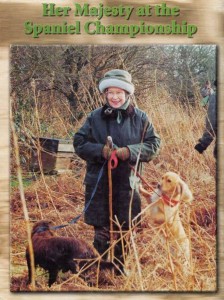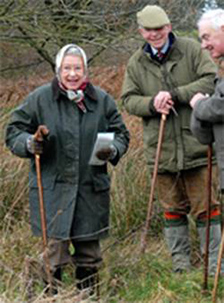Gun Training – Spaniel Training & Hunting, Hunting Dogs
A brief word about the addiction, it’s causes and how it’s nurtured ( published in Spaniels In The Field – summer 2002 )
The first broad exposure most American bird hunters had to good quality wood on a production shotgun came when the Parker Reproduction was introduced in 1984. We also got our first real look at California Claro Walnut.
The wood on most of these Parker Reproductions was highly finished “3 Star” (a midrange grade generally defined as one side, Very Good, one side Good) California Claro walnut. It was beautifully fitted and finished with meticulous Japanese craftsmanship and Italian leather-cased for perfection. Everyone liked what they saw. Little did we know that we were witnessing the birth of a firearms marketing paradigm that was to be embraced by many shotgun makers in the decades that followed: Good wood sells guns. Great wood, like gold, is where you find It Today, the demand for high grade wood exceeds the supply. Here’s the problem — when a sawyer opens a tree it is not unlike opening a surprise package. On average, only 5% of the blanks he cuts can be defined as high grade. The best opportunity for a top-graded piece of wood will come from the crotch of a big, old walnut tree — at least 50 years old — but preferably 75 or 100 years. The traditional sources of great wood -England and France — don’t have many century-old walnut trees left to cut. But their progeny live on all around the world. Today’s country-of-choice for great wood is Turkey where large, ancient walnut trees can still be found. Trophy pieces of Turkish Exhibition Grade wood can be priced well into four figures and simply the reputation of Turkish wood has pushed prices of all high grade Turkish wood higher. The Russian Republics have discovered that those old walnut orchards have become a major assets in world trade. Australia produces some great “English” walnut. My friend, Jack Rowe — who describes himself as “America’s oldest English-trained gunsmith” — has added a few pieces of Kashmir Walnut to his own larder. He buys it from a retired Indian Army Major who gets it out (with an armed guard) of one of the most dangerous places on earth — the Kashmir valley –that disputed territory between Pakistan and India. Gunstock wood is a global business today. A bigger bang for the buck As beautifully demonstrated by the Parker Reproductions, California English and Claro Walnut is not only handsome, but cheaper that many European walnuts. If you compare Turkish with California walnut, grade for grade, you’ll find that Turkish is priced about 2X to 3X higher. The California walnuts give you a much bigger, much more beautiful, bang for the buck. The center cut is the prime part of the crotch The center slab taken out of the crotch might show wildly gorgeous, gaudy, curling feathering on both sides. Or it might not. Skill plus the luck of the cut applies here. But this is where Exhibition Grade wood comes from. Among wood aficionados it is, as they say, “to die for.” And it is always priced accordingly. The slabs on either side of the center slab will probably have feathering on one side and flame on the other. The two outside those will have flame and marbling, then fiddle back, then good contrasting stripes, then plain wood with good grain flow and on out to sap wood. The farther you get from the center, the straighter/fainter the grain/figure and the lower the price. That’s the good news. Here’s the bad news. The 5% rule is narrowed still further Cecil Fredi, who cuts and sells gunstock blanks, sums it up this way: … if a slab has feather in it we cut it for a rifle or an over/under size blank with a pistol grip because it will bring two to three times what a side-by-side blank will. Since rifle and over/under blanks will sell for 2X to 3X more than a side-by-side blank, there’s less financial reward to cut high grade wood for side-by-side shotguns. This rarity moves the price for higher grade side-by-side blanks (and pumps and semi-autos as well) back up on the pricing scale. Tricky, tricky. The Wood Nut’s Reward Virtually every shotgun manufacturer today — taking a page out of the Parker Reproductions play book – utilizes upgraded wood somewhere in their marketing program. You have only glance at their colorful print advertising or literature to get a feel for it. Merkel introduced “Luxury Grade” wood to their line a couple years ago. Browning’s high grade Citoris all feature more engraving and upgraded wood with some of the best of both appearing on Grades III, VI and the new 525 Golden Clays. Franchi’s AL 48 Deluxe semi autos and Alcione over/unders offer “Select Walnut” as standard. Remington doesn’t discuss wood grades much in their catalog, but some of the wood I’ve seen on newer M1 100’s has to have come out of their Custom Shop. Ithaca Classic Doubles has a $28,000 model featuring (as you may have guessed) a piece of highest grade Turkish crotch wood. Both Berreta and FABARM have enhanced wood techniques on some models that give the illusion of high-priced wood, but without the higher cost. A couple of years ago the head of SKB here in the U.S. told me that he personally hand-picks every piece of wood that goes on SKB’s three shotgun grades and AYA, the great Spanish maker, puts the same grade wood on Bill Hanus Birdguns and model 4/53 shotguns that they put on their $4,700 Model 53 custom sidelock. “I’m a bird hunter of course, but…” That’s it. You’re hooked. When the “but” means you like nice wood on a shotgun (and who doesn’t?) you’re a wood nut. You’re one of us. Welcome to the club. “Some days life kisses you right on the lips” (from the Garfield comic strip) and applicable to this California English Crotch Walnut blank. Hard to find certainly –and pricey when you do — but a smackeroo you’ll never forget.
BILL HANUS www.billhanusbirdguns.com



